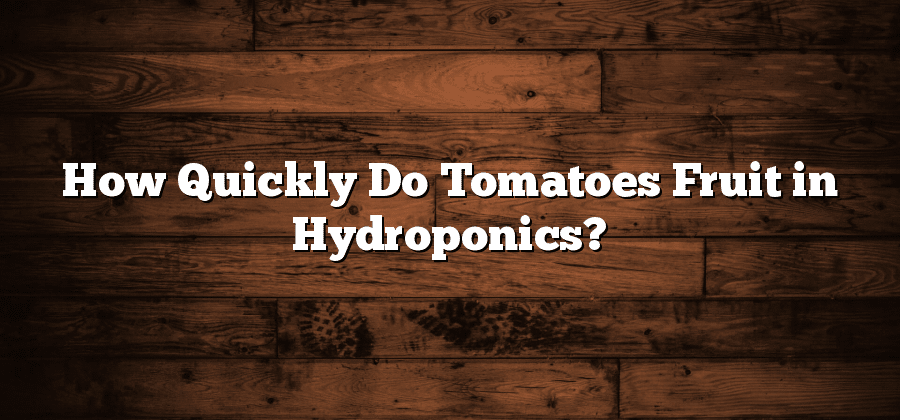Tomato Varieties Suitable for Hydroponics
When it comes to choosing tomato varieties for hydroponic systems, there are several factors to consider. First and foremost, it is crucial to select varieties that have been specifically bred or selected for greenhouse or indoor cultivation. These varieties are better adapted to the controlled environment of hydroponics and tend to perform exceptionally well.
One popular variety for hydroponics is the “Beefsteak” tomato, known for its large and juicy fruit. This variety is characterized by its robust growth and high yield potential, making it well-suited for hydroponic cultivation. Another suitable option is the “Cherry” tomato, which produces small, bite-sized fruit that is perfect for salads or snacking. Additionally, there are specialized varieties such as the “Roma” or “Plum” tomato, which are preferred for making sauces or canning due to their dense and meaty texture. By choosing these hydroponic-friendly tomato varieties, growers can maximize their yields and ensure a successful harvest.
Ideal Growing Conditions for Hydroponic Tomatoes
Hydroponic tomatoes offer many advantages over traditional soil-based cultivation. In order to achieve optimal growth and high yields, it is crucial to provide the ideal growing conditions for these plants. The three key factors to consider are temperature, humidity, and light.
Tomatoes thrive in temperatures between 70-75°F (21-24°C) during the day and slightly cooler temperatures of 65-70°F (18-21°C) during the night. Consistency in temperature is essential, as fluctuations can stress the plants and hinder their growth. It is also important to maintain a relative humidity of around 70% to prevent the development of diseases such as powdery mildew. Finally, providing ample light is crucial for the photosynthesis process. Hydroponic tomatoes require at least 12-16 hours of light each day, ideally from full spectrum grow lights that mimic natural sunlight. By creating these optimal growing conditions, hydroponic farmers can ensure healthy, vigorous tomato plants that will produce abundant fruits.
Understanding the Tomato Growth Stages
The tomato growth stages are crucial to understand for successful hydroponic cultivation. By understanding these stages, growers can effectively monitor and manage their plants, ensuring optimal growth and productivity.
The first stage of tomato growth is the germination stage, where the seedling emerges from the seed. This stage typically takes around 7-14 days, depending on the variety and environmental conditions. Once the seedling has emerged, it enters the vegetative stage, where it focuses on leaf and stem development. During this stage, the plant requires ample light and nutrients to support its growth. Regular pruning and training may be necessary to maintain a well-structured plant. As the plant continues to grow, it enters the flowering stage, where it starts to produce flowers. This is a critical stage as it determines the number of fruit that the plant will eventually bear. Proper pollination and the provision of optimal growing conditions are essential during this stage.
Factors Affecting Tomato Fruit Production in Hydroponics
In hydroponic tomato production, there are several key factors that can affect fruit production. One important factor is light intensity. Tomatoes require a certain amount of light to grow and produce fruit, and insufficient light can result in poor fruit yield. It is crucial to provide the tomatoes with adequate light by using high-quality grow lights or positioning the plants in an area where they can receive direct sunlight for at least 8 to 10 hours a day.
Another factor that can greatly influence tomato fruit production in hydroponics is temperature. Tomatoes thrive in warm temperatures, ideally between 70 to 85 degrees Fahrenheit. If the temperature falls below this range, it can cause stunted growth and reduced fruit production. On the other hand, excessively high temperatures can also have a negative impact, as they can lead to blossom drop and poor fruit set. Maintaining a consistent and optimal temperature is essential for ensuring healthy growth and maximizing fruit production in hydroponic tomato systems.
Optimal Nutrient Solution for Tomato Plants
Hydroponic systems provide an efficient and controlled environment for growing tomato plants. One key factor that contributes to the success of growing tomatoes in hydroponics is the use of an optimal nutrient solution. The nutrient solution plays a crucial role in providing the necessary elements for the plants’ growth and development.
When it comes to tomatoes, there are essential nutrients that should be included in the nutrient solution. These nutrients include nitrogen, phosphorus, potassium, calcium, magnesium, and various micronutrients such as iron, zinc, and manganese. Balancing the nutrient solution with the right amounts of these elements is vital to ensure healthy plant growth, flowering, and fruit production. Moreover, maintaining the proper pH level of the nutrient solution is also important to prevent nutrient deficiencies or toxicities that can hinder the plant’s productivity. Overall, providing an optimal nutrient solution tailored to the specific needs of tomato plants is crucial for maximizing their growth potential in a hydroponic system.






